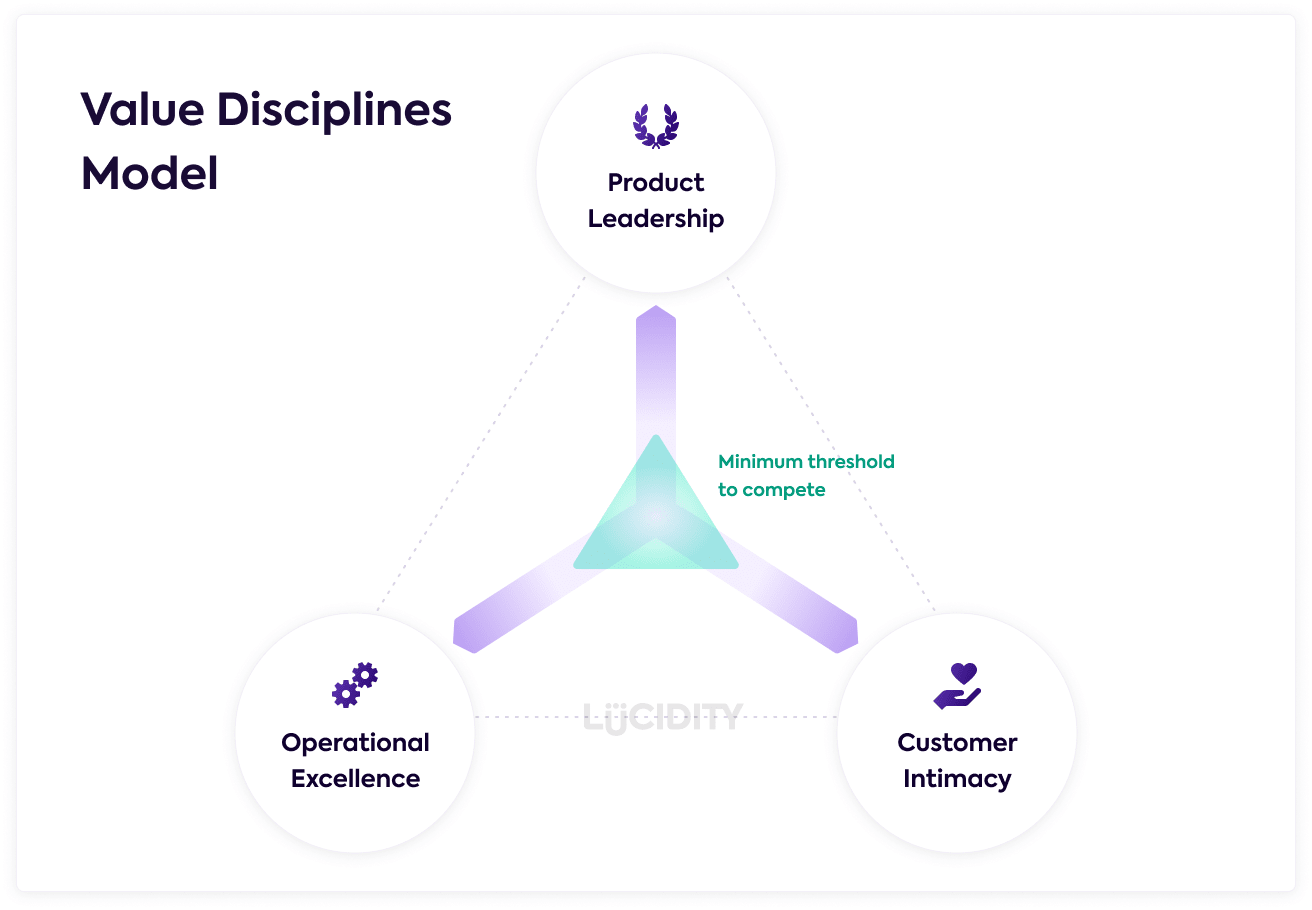In this article we’re going to look at a strategy framework all about helping your growth as a company. It provides three different areas for you to focus on and is designed to be used by companies of all shapes and sizes, from 2 people in a bedroom to 3000 people in offices worldwide… or 3000 people in 3000 bedrooms on Zoom.
What is the Value Disciplines model?
The Value Disciplines model is a business framework that looks at the three competitive areas a company needs to focus on in order to be successful. These disciplines are:
- Customer Intimacy
- Product Leadership
- Operational Excellence
In order to achieve its full potential and become successful, a company must do well in all three areas and become excellent in at least one of them. So, if you want to lead a market you pick one (or maybe two) and you focus. You can’t have all three, so goes the theory…
What is the Customer Intimacy Discipline in the Value Disciplines model?
No surprise based on the name, but Customer Intimacy is the discipline that looks at the relationship between you and your customer.
It goes beyond simply understanding the requirements of your customer and moves into a deeper relationship, with knowledge of their challenges, industries and solid relationships that can ensure low churn and high satisfaction.
Like other disciplines in this model, it needs to be embedded into the company culture so that every interaction with the customer is done in a manner that enhances the intimacy between the two businesses (or the business and the individual consumer).
Companies that specialise in this area often have low churn due to deep relationships with their customers. Traits of these companies include:
- Decision making that rests with individuals closest to the customer
- A Customer Success function complementing Support
- Long lasting relationships and low churn
- Clear understanding of clients and their challenges
It’s the discipline that is hardest to copy as it requires time and energy to understand and relate to the customer.
What KPIs measure the Customer Intimacy Discipline in the Value Disciplines model?
The type of KPIs that are commonly associated with Customer Intimacy involve Customer Churn and Sales Growth. You can find more KPIs that relate to Customer Intimacy in our Complete List of Marketing KPIs and our Complete List of Customer KPIs.
What examples are there of companies that have succeeded through a focus on Customer Intimacy?
Some example companies that have succeeded due to a focus on customer relationships include:
- Hilton Hotels
- Netflix
- Chase Bank
What is Product Leadership in the Value Disciplines model?
Product Leadership is the discipline relating solely to Product Development. This is one of the most common perceived disciplines, as it relates specifically to the tangible product or service provided.
Companies that lead with their product are often vying to stay ahead of their competitors and require investment in innovation or diversification. Common traits associated to this discipline include:
- Creativity & Innovation. This is a key aspect as ideas and innovation need to be maintained
- Commercialism & Sales. The ability to turn innovation into a commercial offering
- Relentlessness & Leadership. Customer expectations change rapidly, as do competitor offerings, so you need to keep moving forward
Although Product Leadership is a good way to stay ahead, it is also the easiest to copy from a competitive perspective.
What KPIs measure the Product Leadership Discipline in the Value Disciplines model?
The KPIs relating to Product Leadership are often financial, as there is often a direct relationship between the product development and performance of the company, as well as product specific KPIs. Product focused KPIs range from Churn Rate to Usage Frequency. You can find more in our Complete List of Product KPIs.
What examples are there of companies succeeding through Product Leadership?
I know you’re all thinking Apple, right? Their iPhone was absolutely a Product Leadership success, but they’re not alone. Others include…
- Lego
- Google Search
- Dyson
What is Operational Excellence in the Value Disciplines model?
The Operational Excellence discipline focuses on your operational model and your ability to provide a product or service at the lowest price possible for the market. With Operational Excellence focused companies there’s real attention paid to the internal workings of the business and how you translate the inputs to the outputs.
There are several areas of focus when you’re an Operational Excellence company including:
- Personnel Management to ensure the team is fully focused on efficiency
- Transactional Management to ensure full efficiency in the process of creating your value
- Systems Management to ensure full visibility across the process
Common traits of this type of company include:
- A focus on automation
- Lowest price point in the market
- A culture of efficiency and transparency
- A product or service that is unlikely to be the best but will do a good job
If you’re looking at this as your leading Discipline, it will be worth exploring Porter’s Value Chain model and analysing how you produce your output.
What KPIs measure Operational Excellence Discipline in the Value Disciplines model?
The financial KPIs around costs are often the ones used to measure Operational Excellence. Take a look at our Complete List of Financial KPIs for guidance on some of these.
What examples are there of companies succeeding with a focus on Operational Excellence?
Companies that are successful by offering really low perceived prices. So now we’re definitely not thinking Apple! How about the following as examples:
- RyanAir
- Lidl in the UK
- Dollar Shave Club
How do I decide which Discipline to use for my company?
Deciding which of the disciplines are going to become your core focus requires some research into the following areas:
The Current Market
Take a look at Five Forces and examine your current market. What impacts you and your customers when it comes to price point?
Your Competition
Have a look at Four Corner Analysis and the top competitors in the market. Using this tool, you can estimate both their strategy and which of the Value Disciplines they focus on. How will you respond?
Your Own Skills & Capabilities
What are your skills and capabilities as a business? It might be that you can’t afford to have the cheapest price or process but you have excellent experience in focusing on customers. Perhaps you have the best R&D team or product and streamlined processes, but no focus on customers? The VRIO model can help you assess your capabilities and find your answer.
Finally, it’s important to keep in mind that you need to have a base in all three Value Disciplines to be truly successful. If you ignore one, your chances are greatly reduced.
Can I be great at all three Disciplines?
It’s tough to do all three. You can be good at them but the model suggests you can’t be great. But that’s ok, you don’t need to be great at all three to be hugely successful. Look at Lego, they’re great at product innovation and knowing their customers, but nobody can say they do cheap when the kits can go into the hundreds. It’s best to focus on the one or two you know you can really use to succeed.
What are the advantages of the Value Disciplines model?
There are a number of advantages to this model including:
- It works for any stage of your company growth
- It allows focus on strategic objectives
- It provides a simple method for positioning your business
What are the disadvantages of the Value Disciplines model?
The main disadvantages to the model are:
- The model is not an exhaustive look at different approaches
- It requires other models to function well for a company
What are the alternatives to the Value Disciplines model?
Bowman’s Strategy Clock and Porter’s Generic Strategies are two alternative models for establishing how you place yourself in a marketplace, though don’t always provide the value focus. You’ll see in these other frameworks that the Value Disciplines model complements certain positions. Which leads us to…
What tools work well with the Value Disciplines model?
Porter’s Five Forces is also a good tool to use in conjunction with Value Disciplines, as it provides a view of the landscape and an understanding of what factors influence your pricing and profitability. Beyond this, any framework you use to decide your market position works well with Value Disciplines. Finally, once you’ve decided your position, Porter’s Value Chain is a useful complementary toolkit.
Who invented the Value Disciplines model?
The Value Disciplines model was created by Michael Treacy and Fred Wiersema in their book The Discipline of Market Leaders.













